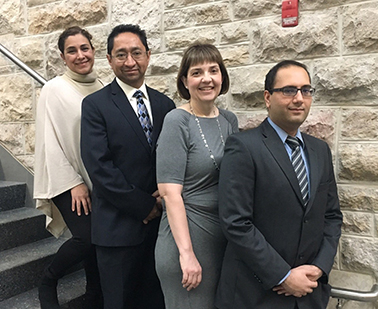
Professor Jose Tellez-Zenteno and colleagues argue the need for a dramatic change in the way epilepsy is treated, and explain how the single seizure clinic could help
Epilepsy comprises more than 40 clinical syndromes, affecting 50 million people worldwide. Globally, epilepsy constitutes an unmet need and one that requires an extensive re-think on how to implement patient-oriented care paradigms that address the fundamental issues of timely access, resource allocation, and collaborative care. The ongoing issues regarding epilepsy care over the years are a sobering reminder of the essential groundwork that is lacking and should behoove the epilepsy community and its advocates to act.
The subject of socioeconomic barriers and infrastructure investment to aid the efficient diagnosis and management of epilepsy is vital to the frontlines of epilepsy care and must be given its due in academic, clinical, and research circles. The answers may not be easy to come by, but must be sought, in the duty of beneficence – the ability to do the greatest good for the largest amount of people.
Looking beyond intractable epilepsies
At a macroscopic level, this will require a refocus of priorities from opinion leaders, advocacy groups, healthcare systems, and key societies. For instance, firmly seared in the collective consciousness of the epilepsy community is the issue of intractable epilepsies, which together amount to 30% of the disease burden, yet appear to monopolise much of the academic and clinical discussion.
Intrinsically, the epilepsy community has put its weight behind this effort and the recognition of a prestigious comprehensive epilepsy centre tends to rely heavily on the ability to provide advanced, cutting edge approaches to addressing the most complex of epilepsies. While this is not without merit – indeed great progress in surgical and neuromodulator approaches attests to the tangible benefits of attempting to tackle drug-resistant epilepsy – this somewhat myopic viewpoint fails to address the basic problem of access, faced by the majority of people with epilepsy. A great majority of patients do not require epilepsy surgery or other advanced treatments, and only require guidance on the best medication and education in order to lead a productive life and steel themselves from the adverse socioeconomic, neurobiological, and psychological consequences of untreated epilepsy. Early education can potently deconstruct misconceptions and battle the stigma of the disease.
Regrettably, the onus of caring for their epilepsy often falls on patients themselves, who must shoulder the burden of navigating a needlessly complex series of referrals in order to attain appropriate care. The predictable result is unacceptably long wait-times for diagnosis, tests, and treatment of epilepsy and comorbidities. One example and a major problem in patients with intractable epilepsy is the prolonged time that patients wait to have epilepsy surgery – 20 years on average. What is clear from the outpouring of patient frustration, complemented by available data, is the need for an efficient multi-disciplinary pathway that offers patients care from the onset of their first seizure to more complex management options if necessary.
While the nuts and bolts of this system may vary from region to region, contingent on expertise and resources, the inception of a time-conscious, team-based care approach is a sensible consideration.
The single seizure clinic
Our team has advocated this approach in the formation of a new model of medical attention for patients that addresses the treatment needs of patient with new onset epilepsy through a single seizure clinic (SSC). The SSC accepts any patient considered to have had a first seizure directly from primary care providers and connects them to an epileptologist. The SSC has reduced wait-times for assessment and investigations, clarified diagnoses, and affected management decisions with respect to further workup, first line pharmacotherapy, and driving advice. The SSC serves as a unified point of care for evaluating patients who experience the first seizure in life and appears to capture a patient population at high risk of developing epilepsy.

From left to right; Dr Hernandez-Ronquillo, Dr Jose F. Tellez-Zenteno, RN Karen Waterhouse and Dr Syed Rizvi
In our initial experience of 200 patients, 82 (41%) were diagnosed with epilepsy, and the vast majority of diagnoses were established at the initial visit, thereby enabling SSC epileptologists to properly stratify subsequent care and arrange appropriate follow-up, while avoiding unnecessary investigations. Patient assessments at the SSC occurred within four weeks of referral and ancillary investigations were organised more rapidly, representing a marked improvement over previous care, as wait-times were reduced by 45-89%. The sooner epilepsy is diagnosed, the quicker patients and clinicians can start making decisions about treatment and management that promote seizure remission and positively impact emotional, physical, and economic well-being through the redress of issues of unemployment, loss of independence, psychiatric morbidity, stigmatisation, and early mortality. The model also provides the opportunity to advocate advanced treatment such as epilepsy surgery earlier in the course of the disease. The SSC model is now becoming prevalent in other centres in Canada.
It is understood that epilepsy care spans a continuum in which making the diagnosis is merely the first pivotal step in guiding a patient towards a positive outlook on their epilepsy and in addressing the challenges that a patient’s epilepsy may pose. It is our hope that readers will take from this article the idea that there is a pressing need for early, urgent specialist input in patient care. Implicit in this recognition is the requirement to re-work institutional and health systems approaches to develop and make accessible epilepsy specialist expertise and standard of care diagnostic testing to patients as soon as they declare themselves to have epilepsy, potentially at the time of their first seizure.
This approach is a drastic re-working of the situation that exists today in which epilepsy treatment gaps are the norm, and has the potential to remove any treatment gaps and truly establish a continuum of care for all patients and all epilepsies. The upside is huge and life-affirming for individuals and societies, as care models such as the SSC can potentially mitigate the devastating social consequences and poor health outcomes resulting from untreated epilepsy.
Professor J F Téllez-Zenteno
Division of Neurology, Department of Medicine, Royal University Hospital
Tel: +1 306 844 1134
Dr Syed Rizvi
Clinical assistant professor
University of Saskatchewan
Dr Lizbeth Hernandez-Ronquillo
Clinical assistant professor
University of Saskatchewan
Karen Waterhouse
Saskatoon Health Region
Please note: this is a commercial profile










